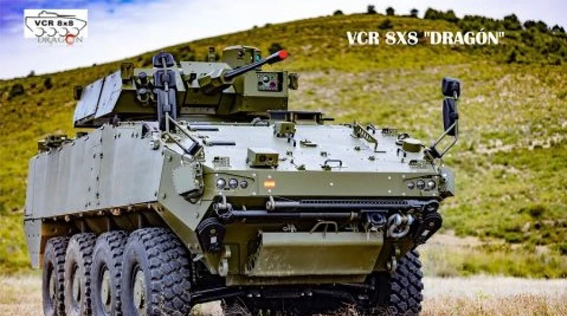VCR 8×8 Dragón, the expected armored vehicle on wheels of the Army for its brigade of the future
The Spanish Army has begun to receive its new 8×8 Dragon Combat Vehicle on Wheels (VCR), a platform that will be the backbone of its future Brigade 35. After years of waiting, this Tuesday the first seven units of the sapper version of the armored vehicle were delivered.
The entire program is managed by the Tess Defense company, made up of Santa Bárbara Sistemas, Indra Sistemas, Sapa Placencia and Escribano Mechanical & Engineering. SBS provides the barge (starting with the Piraña V), reinforced against mines and IEDs, and is responsible for the integration of the vehicle at the Trubia plant (Asturias), although the first units have been assembled at the Alcalá de Guadaíra factory ( Seville). Indra develops the innovative mission system; Sapa, the powertrain, which includes a new transmission; and Escribano, the Guardian 30 and Guardian 2.0 12.7mm remote weapon stations.
The program aims to achieve the objective of 70% participation of the national industry in the development and production phase of the VCR 8X8. The contract for the first phase contemplates 348 vehicles in five versions, some with different variants: VCI (Infantry Combat Vehicle) version, 219 vehicles in four variants; VEC version (Cavalry Exploration Vehicle) 58 vehicles in four variants; VCZ (Sapper Combat Vehicle) version, 49 vehicles in two variants; VC PC Bon/Gr version (Battalion/Group Command Post Combat Vehicle), 14 vehicles; and Vcoav (Forward Artillery Observer Combat Vehicle) version, eight vehicles. Deliveries are planned over the next five years, until 2027.
The 219 vehicles of the infantry combat version will carry Escribano’s Guardian 30 tower, designed and built in Spain. Its main weapon is a 30mm MK44S cannon adaptable to 40mm, and it incorporates a 7.62mm MG5A1 machine gun and two Oteos electro-optical systems, one for the shooter and one for forward vision located on top of the turret. In addition, it will integrate the Spike anti-tank missile, in service with the Spanish Armed Forces, of which Defense will buy a new batch.
For its part, the sapper and forward observer versions will carry the Guardian 2.0 with a 12.7mm machine gun and, in the case of the scout version, the decision on the weapon station has not yet been made. Both towers have a two-axis gyro-stabilized mount, laser rangefinder, visible HD and IR camera, automatic video tracker and integrated simulator for training.
Technical characteristics
The vehicle has a range of more than 500 km with a maximum authorized mass of 33 tons, a payload of 9.4 tons and a maximum speed of more than 100 km/h. It incorporates independent McPherson type suspension with height adjustment and a tire pressure adjustment system for each terrain. The dimensions are as follows: 8.3 meters long by 2.9 wide. It is designed for a crew of three: vehicle commander, driver and shooter, and will carry up to six additional fighters.
It will be able to overcome longitudinal slopes up and down (with or without stopping) maximum of 60% and lateral slopes of up to 30%. It is also designed to clear vertical obstacles of 800mm to the front and 600mm to the rear, fording waterways and sunken areas of up to 1.5 metres, as well as crossing trenches of up to 2 metres.
The powertrain will consist of the Scania DC13 six-cylinder in-line engine and the SW624 transmission from the Basque company Sapa. In addition, it has an electric power generation system on board, also from Sapa, consisting of a 75 kW electric machine, an AC/CD 72 kW inverter and a 20.4 kW DC/DC converter, a 16 kW power unit and a module export power of 69 kva. The power of the vehicle will reach 540 kW.
The brain of the Dragon will be the Indra mission system, with the BMS-VCR or battlefield management system as one of the main components. This solution will evaluate based on the position, trajectory of the vehicle and situational information in real time, which is the best option to take to guarantee the success and fulfillment of the mission. The mission system will also integrate EO/IR sensors, communications, alerts, active protection, weapons, navigation aids, and other systems such as drones or combatant equipment on foot. It will have zero data loss and zero recovery time protocols, degraded mode operation capability, open, modular and scalable network architecture and double fiber optic ring.
Tess Defence, as prime contractor and design authority, has closed several contracts to equip the 8×8 VCR with different equipment and systems. Leaving aside the tower, the most important is the radio. The vehicle will carry E-Lynx radios from the Israeli Elbit Systems, which has Telefónica and Aicox Soluciones as suppliers in Spain. Other Spanish companies are also taking part in the programme, such as Tecnobit, which supplies the screens (displays) from which the external cameras are managed to support the driving of the mission system, or GMV, responsible for the Isnav navigation system. For its part, the Israeli company Plasan will supply an armor package against RPGs, mines and IEDs.
Regarding protection, the vehicle will incorporate anti-mine flooring, Stanag Level 5/6 armor with add-on kit, selective reinforcements in different parts (sides, front, tower…), anti-fragmentation coating (spall liner) and ballistic seats. It is also planned to provide the vehicle with an active protection system, still pending contracting.





